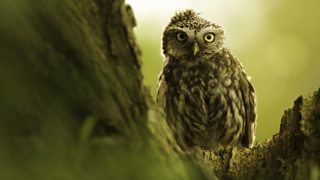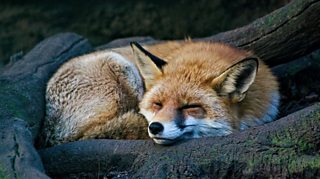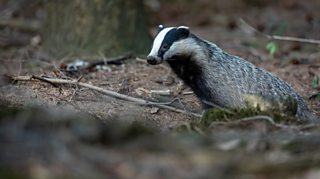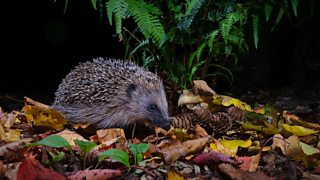By Amber Jepson, Bangor University
For the UK’s wildlife, autumn is a time to reap the bounties of summer and prepare for grim winter weather. As the days grow shorter, nocturnal wildlife begins to enjoy longer and darker nights.
We will explore the phenomenon that is nocturnal wildlife, so you know what to spot this autumn.
Find out the best way to use your space to help wildlife with Naturehood, where you can find free guides, tips, ideas and resources to help you create your !
Bats

Here in the UK, we have 18 native species of bat, with some more common than others.
The common pipistrelle bat (Pipistrellus pipistrellus) for example, is the second most common bat you will see anywhere across the UK. You can often spot them from gardens, as well as near water sources, such as lakes, ponds, and rivers.
Most bats can be found within dense woodlands, open farmland, grassland, and even busy urban areas. They can inhabit the usual wild habitats such as crevices in trees and the depths of caves, or they can also feel at home in buildings and rooftops, as well as commonly seen taking up residence in churches, where there is plenty of space in rooftops and overhangs that provide darkness in the daytime.
Bats are interesting mammals, as they have the ability to fly, whilst also possessing the ability to use sonar – echolocation. Bats having bad eyesight is a myth, as they are actually quite well adapted to see and are not completely dependent on echolocation to survive.
Echolocation helps bats to navigate their environment and to locate and catch their prey during night time, whilst using their good eyesight to locate food during the day.
Owls

Image by Nathan Benstead
Listen out for the tawny owl’s (Strix aluco) hooting calls throughout the late autumn and winter months, when the mating season for this species begins. You can expect to see the barn owl (Tyto alba) this time of year in the twilight hours, mostly gliding over fields in search of their prey.
The UK is also home to the long-eared owl (Asio otus). No bigger than a wood pigeon in body size, the beautiful long-eared owls are a rarity in the UK, as they are critically endangered. The long-eared owl can be seen during its local migrations during any time of day, or you will have better luck spotting them in winter when they are travelling to and from their roost sites at night.
All UK owls are adapted for night time activity, so all have fantastic eyesight which allows them to detect any light that is available.
Fox

A more familiar nocturnal British predator is the red fox (Vulpes vulpes). Foxes can be seen from dusk and through the night wandering in search of small rodents, rabbits, and voles, as well as the occasional bird. Foxes even like their share of beetles and earthworms.
Foxes are adaptable survivalists, living in either countryside, woodland, or urban areas. During the late autumn and winter months, you may be able to hear a fox vocalising, as this is the time they usually exercise their call. Foxes are usually silent creatures – but at this time of year you may hear their bloodcurdling barks.
Badger

The European badger (Meles meles) is also a nocturnal UK species. The badger usually makes their home in underground burrows they create using their large claws to dig, called setts. These setts can usually be found in broadleaf woodlands or anywhere where there are plenty of earthworms. You can usually find elderberry bushes close to badger setts, as badgers love to browse these bushes, as well as feast on apples, plums, and pears.
Badgers also eat mice, rats, frogs, toads and rabbits. Badgers are very social creatures, and live within family groups, called clans. Usually, there are six badgers in each family clan that shares a territory. To reinforce their territory boundaries, badgers have a series of latrines stationed around their territory to help ward off conflict with other badgers.
Hedgehog

Image by John Formstone on Flickr
And now we come to Britain’s favourite mammal - the hedgehog (Erinaceus europaeus). These spiny little hogs are night time foragers, always after their next creepy crawly snack, or best pick of juicy fruit and veg.
Hedgehogs must forage and eat as much food as they can during autumn, so they are prepared for hibernation during the harsh winter months. Hibernation is when colder weather and temperatures cause an animal to go into a state of inactivity, by slowing their heart rate and breathing, as well as lowering their body temperature and metabolism. Because of this, hedgehogs can eat less during their state of inactivity.
In their urban habitat, they usually take up residence in piles of logs, underneath garden sheds and porches, and in compost heaps. Depending on the temperature, hedgehogs usually go into hibernation around October or November, though if temperatures are warm enough you might still see hedgehogs trudging about in December.
To help hedgehogs find a safe refuge for the winter, try and keep a section of your garden untidy, so the hedgehogs have long grass to hide in, leave stacks of logs of twigs somewhere within your garden, provide small wooden hedgehog boxes for them, as well as accessible food. Fences usually stop hedgehogs from moving around through gardens easily, so a small effort to make a hole big enough for hedgehogs to fit through would make all the difference towards their survival.
